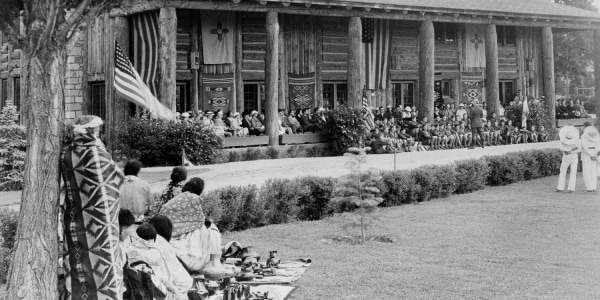This city and neighboring nuclear lab appeared to be out of fire danger, at least for now, but officials said Thursday that sacred Native American sites had burned and that the fire was now threatening the town of Santa Clara Pueblo.
"Today is a good day for parts of this fire. It's a bad day for other parts of this fire. Our hearts go out to the folks that are suffering the bad part," Los Alamos County Fire Chief Doug Tucker said at a press conference.
Resources were shifted to keep the fire from moving down a canyon toward Santa Clara Pueblo, about seven miles away. Established around 1550, the town has a mostly indigenous population of around 1,000.
Above the canyon on Chicoma Mountain, sacred areas were burning, fire operations chief Jerome MacDonald said. New Mexico's Pueblo people consider Chicoma, the highest point of the Jemez mountain range, as the "center of all." The Puye Cliff Dwellings are in the Santa Clara Canyon.
Santa Clara Pueblo officials issued a statement saying the fire had burned through 6,000 acres of its watershed.
"Our canyon is the source of our Santa Clara Creek that we rely upon for irrigation but, more than that, it was a beautiful place of abundance in wildlife, clean water, culturally significant trees and medicinal plants," said Santa Clara Pueblo Gov. Walter Dasheno.
The fire has chewed up tens of thousands of acres a day since it started Sunday, charring nearly 145 square miles, or 92,735 acres, by Thursday morning.
Fire officials believe the blaze will soon surpass the largest fire in New Mexico history, one that burned more than 94,000 acres of the Gila National Forest in 2003.
They were bracing for 40 mph gusts and temperatures in the 90s as spot fires continued to pop up Thursday afternoon.
As firefighters held the line along the lab's southern border, thousands of residents remained out of their homes. They were told they would not be able to return by Saturday as officials had hoped on Wednesday.
Containment is still at three percent, but an operation Wednesday to burn off vegetation just outside Los Alamos National Laboratory was declared successful by firefighters late Wednesday.
In a , LANL Director Charles McMillan spoke of feeling "the heat of the fire on my face" as he praised emergency personnel for risking their lives to fight the blaze.
The deliberate fires created a 10-mile long burned out area between the wildfire and the lab.
Tucker said in the statement that the burns had been successful.
"In my professional opinion, there is a less than 10 percent chance of spot fires on Lab property this evening, diminishing tomorrow (Thursday)," he said.
"It's looking good right now," Tucker added.
The statement added that there were no wildfires currently burning on laboratory property and said all of its nuclear and hazardous materials were safe, accounted for and protected.
The laboratory posted video of a .
The lab has been shut down since Monday, when all of the city of Los Alamos and some of its surrounding areas — 12,000 people in all — was evacuated.
There was no word on when it will reopen, but it was expected to remain idle at least through Friday.
Officials said the Los Alamos National Laboratory has some 10,000 experiments running at the same time that have been put on hold.
"We have a range of projects, some of them have shorter time deliverable, some of them are years to decades," McMillan said in an interview with The Associated Press.
Among the work delayed are experiments run on two supercomputers, the Roadrunner and Cielo.
The National Security Administration's three national laboratories — Los Alamos, Sandia, and Lawrence Livermore — all share computing time on Cielo, which is among the world's fastest computers.
Also delayed is work on projects ranging from extending the life of 1960s era B61 nuclear bombs to studies on how climate change affects ocean currents. The computer allows scientist to look at different scenarios, including changes in currents and the melting of the ice caps.
On Monday, about an acre of lab property burned, raising concerns about possible contamination from material stored or buried on lab grounds.
Planes monitor radiationAs a precaution, the government sent a plane equipped with radiation monitors over the lab. Samples analyzed so far from some of the lab's monitors show nothing abnormal in the smoke.
Lab authorities described the monitoring from the air as a precaution, and they, along with outside experts on nuclear engineering, expressed confidence that the blaze would not scatter radioactive material, as some in surrounding communities feared.
"The nuclear materials are secure," said Penn State University nuclear engineering professor Barry Scheetz, who has served on National Academy of Sciences nuclear review boards and has been to Los Alamos several times. "There's multiple redundancy in the protection of this material."
Anti-nuclear groups have sounded the alarm about thousands of 55-gallon drums containing low-grade nuclear waste — gloves, tools, even paper notes and other contaminated items — about two miles from the fire. Lab officials said it was highly unlikely the blaze would reach the drums, and that the steel containers can in any case withstand flames and will be sprayed with fire-resistant foam if necessary.
